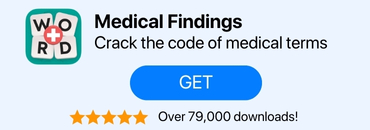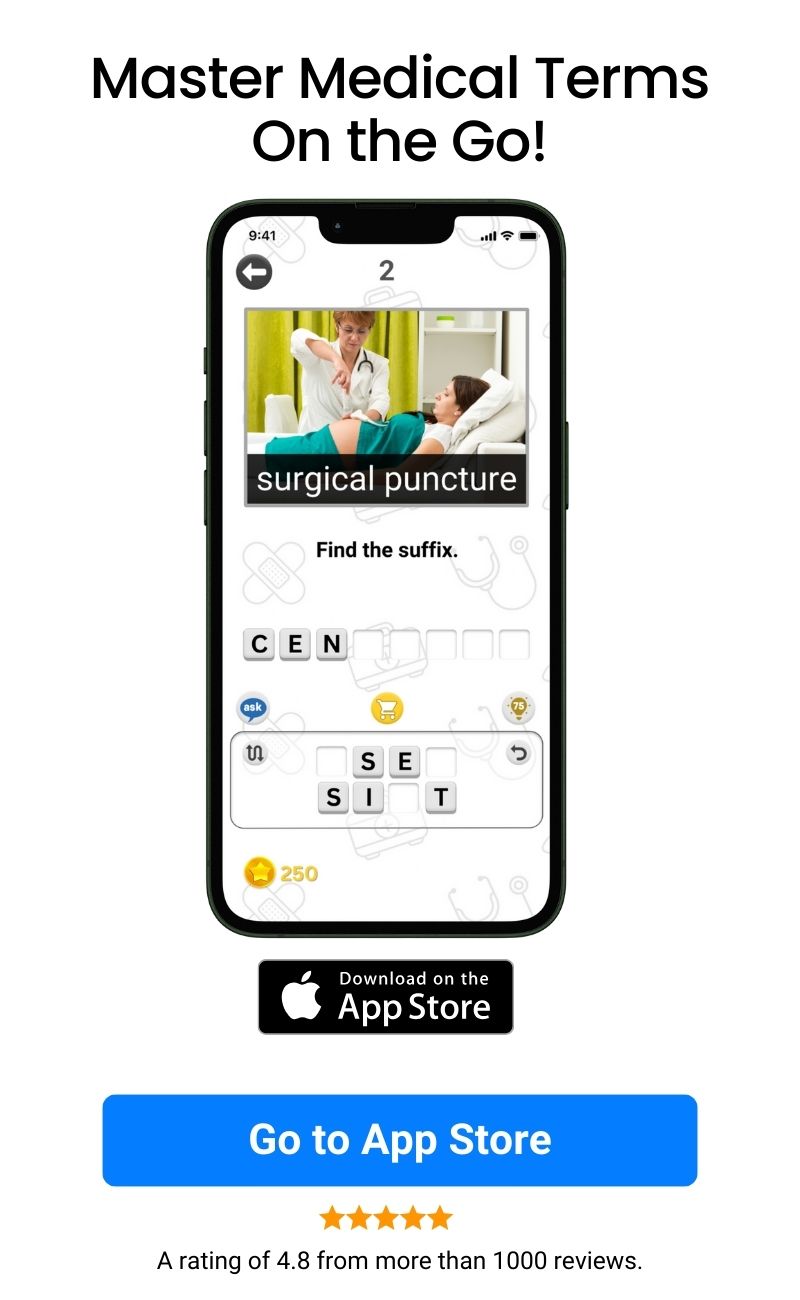The goal of this quiz is to help you learn some of the most common word roots and combining forms related to the skeletal system.
Quick Review for the Quiz
Check out the flashcard version for a more detailed review.
| Word Root | Combining Form | Body Part or Condition |
|---|---|---|
| ankyl | ankyl/o | stiff, bent |
| aponeur | aponeur/o | aponeurosis |
| arthr | arthr/o | joint |
| burs | burs/o | bursa |
| carp | carp/o | carpals, wrist |
| chondr | chondr/o | cartilage |
| clavic, clavicul | clavic/o, clavicul/o | clavicle (collarbone) |
| coccy, coccyg | coccy, coccyg/o | coccyx |
| cost | cost/o | rib |
| crani | crani/o | skull or cranium |
-
Question of
Find the combining form of the image highlighted.

-
ankyl/o
-
stiff/o
-
vertebr/o
-
ili/o
Correct Wrong
ankyl/o is a combining form that refers to "stiff" or "bent". The word stiff is used to describe something that is rigid and not easy to bend.
-
-
Question of
Find the combining form of the image pointed to.

-
aponeur/o
-
sheath/o
-
pub/o
-
ankyl/o
Correct Wrong
aponeur/o is a combining form that refers to "aponeurosis". Aponeurosis is a very thin layer of connective tissue that attaches muscles to bones. Aponeuroses resemble tendons. They bring stability and strength to the body and stabilize the muscles. Aponeuroses also function as energy-absorbing tissues during muscle contractions.
-
-
Question of
Find the combining form of the image highlighted.

-
arthr/o
-
joint/o
-
patell/o
-
tars/o
Correct Wrong
arthr/o is a combining form that refers to "joint". A joint is a place where two or more bones meet at a point on their surface. The majority of joints are mobile, so the bones are able to move as a result. There are several components that make up a joint: cartilage, synovial membrane, ligaments, tendons, bursas, synovial fluid, and meniscus.
-
-
Question of
Find the combining form of the image pointed to.

-
burs/o
-
scapul/o
-
ischi/o
-
coccy
Correct Wrong
burs/o is a combining form that refers to "bursa". A bursa is a small, slimy sac filled with fluid that acts as a shock absorber between the layers of soft tissue and bone. The major bursae (plural of bursa ) are situated close to the tendons near the major joints, like those in the shoulders, elbows, hips, and knees.
-
-
Question of
Find the combining form of the image pointed to.

-
carp/o
-
wrist/o
-
tars/o
-
scapul/o
Correct Wrong
carp/o is a combining form that refers to "carpal (wrist)". The carpal bones are the eight small bones that make up the wrist (or carpus) that connects the hand to the forearm. Wrists are mainly used to enable efficient movement of the hand and effective and strong use of the forearm extensors and flexors, and their mobility enhances wrist movement.
-
-
Question of
Find the combining form of the image highlighted.

-
chondr/o
-
cartilig/o
-
synov/i
-
aponeur/o
Correct Wrong
chondr/o is a combining form that refers to "cartilage". Cartilage is a tough, flexible connective tissue that cushions joints and bones. As a result, it serves as a shock absorber in and around the entire body. Bone cartilage reduces friction and keeps bones from rubbing together when the joints move.
-
-
Question of
Find the combining form of the image highlighted.

-
clavic/o
-
collar/o
-
femor/o
-
tendin/o
Correct Wrong
clavic/o or clavicul/o is a combining form that refers to "clavicle (collarbone)". The clavicle (collarbone) is the thin, elongated, subtly curved bone that attaches the arm to the body. It is located below the neck and makes up part of the front of the shoulder. It extends horizontally (from left to right). It connects the sternum in the center of the ribcage to the shoulder blade (scapula). The clavicle is susceptible to injuries, including fractures, dislocations, and separations. The most common cause of collarbone injuries is falls.
-
-
Question of
Find the combining form of the image highlighted.

-
coccyg/o
-
tailb/o
-
radi/o
-
oste/o
Correct Wrong
coccy or coccyg/o is a combining form that refers to "coccyx (tailbone)". The coccyx is a triangle-shaped piece of bone that forms the bottom end of the spine beneath the sacrum. Even though the tailbone is regarded as unnecessary in the human body, it serves a purpose in the pelvis. As an example, the coccyx is a part of a three-part support for a person in the sitting position.
-
-
Question of
Find the combining form of the image highlighted.

-
cost/o
-
rib/i
-
chondr/o
-
synov/i
Correct Wrong
cost/o is a combining form that refers to "rib". Ribs are a row of curving bones on the chest that are attached to the spinal column in pairs. These bones provide support for the body wall and protect the internal organs.
-
-
Question of
Find the combining form of the image highlighted.

-
crani/o
-
skull/o
-
stern/o
-
scoli/o
Correct Wrong
crani/o is a combining form that refers to "skull" or "cranium". The skull consists of the bones that make up the head. The cranium is the area of the skull composed of the bones containing the brain, excluding the bones of the face and jaw.
-




